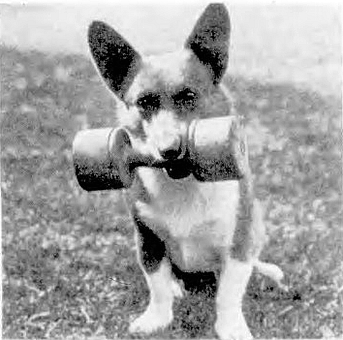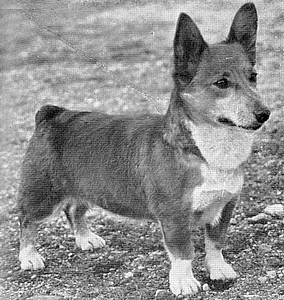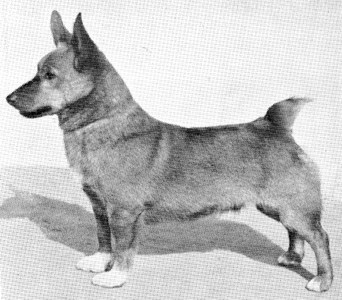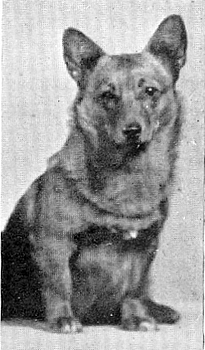The Andelys Kennels
The great ladies who got the breed going on the East Coast of the USA in the last 1930s were brilliant at gaining publicity for the Pembroke and for their own kennels, none more so than Barbara Fallass of the Andelys.It helped that they were all experienced dog people, already successful in other breeds. Not long after Mrs Fallass came into Corgis, this wonderful spread on the Andelys kennel was published in the AKC Gazette (December 1938). Sorry the end of the article is missing.
Simon Parsons on Facebook
16 January 2021
Why the Andelys Kennels Believes the Pembroke Welsh Corgi is the Finest Companion
By Arthur Frederick Jones
When a great ship slides down the ways it is an especial occasion; an occasion of much pomp and circumstance. The launching marks the culmination of many men's work, and they proudly see a name attached to the result of their efforts. But that name means nothing. The ship which bears it must make that name into a personality. The new liner must be welded to its crew. In time, the name will stand more for service and esprit de corps than it will for the mere physical proportions of the ship.
As with a ship, so it is with everything else in life. Names are mere collections of letters until they have been tempered in the furnace of experience. Names are merely symbols, but these symbols often live long after what they symbolize has disappeared.
So ran my thoughts when, recently, I visited the Andelys Kennels of Mrs. Barbara Lowe Fallass at Cross River, N.Y., and saw one of the grandest collections of Pembroke Welsh corgis that ever has been assembled in the United States. But as interesting as the dogs was the charming personality which the owner has managed to wrap around the kennels. Within less than a year after entering competition in America, this establishment has become as well, and almost as widely known as kennels that have been breeding and showing in America for many years.
The Andelys affix is new to canine ranks in the United States, but it hardly is new to the sport. Prior to establishing her kennels at Cross River, Mrs. Fallass maintained a kennel in France, where she lived for 15 years. The name of her kennel is taken from that of her home in Normandy, "Les Andelys", and it is thus fraught with many pleasant memories. While in France, Mrs. Fallass bred and exhibited a succession of splendid dogs. Some were specimens that could have set a dazzling pace in any country. There were many other breeds, but the favorites were smooth fox terriers.
As one talks to Mrs. Fallass, one gets a broad vision of what it really means to love good dogs. She draws no hard and fast rules, and sets no boundaries as to breed or type of breed. In fact, it soon becomes apparent that she could hardly do this since she has owned, at one time or another, dogs of more than two dozen different breeds. Life just would not be right without dogs; and to her, dog-appeal is not a virtue restricted to any one breed.
While there is plenty of sentiment in the background of the Andelys Kennels, it would be veering rather sharply away from the truth to say that Mr. Fallass is a sentimentalist in so far as her dogs are concerned. There is no doubt that she loves dogs, but above everything else she has a keen eye for a good one. Perhaps this is a heritage from her English father, for the English have been steeped in the doggy tradition for so many generations that they seem able to pick out good ones blind-folded.
When Mrs. Fallass first saw Pembroke Welsh corgis in England, she took an immediate interest in the breed. They had just been recognized in that country, but they were catching popular fancy in amazing fashion. Still living in France, the owner of Andelys decided to wait a little while before she added the "new" breed to her kennels. To the surprise of many, corgis did not drop from sight following their sensational debut. They continued to grow in favor. Later, they were introduced into the United States with equal success.
It was the spontaneous welcome received by the corgi in America that finally influenced Mrs. Fallass to start collecting foundation stock. This was just about the time she was moving to the United States, and, consequently, the dogs purchased in England were shipped directly here. They took up their abode in picturesque surroundings at Cross River - in a section of country very much like the Welsh shires from which the breed came, originally.
To many in the United States the corgi is a mysterious variety of dog. The vast majority has seen neither the Pembroke nor the Cardigan Welsh corgi. For that reason, it might at least be well to mention something of the history of the Pembroke, which is the breed most favored by Mrs. Fallass and the more numerous in this country. Incidentally, the Pembroke has moved ahead at a fast rate because it has a certain style and alert appearance, due, in a great measure, to its short tail and prick ears.
Half a dozen years ago even the veteran dog fanciers of this country were totally unacquainted with the name "corgi". It was something so new to the American fancy that there were many and fantastic conjectures as to its meaning. The meaning is really very simple, being merely, "little dog", and it was used by the Welsh hillmen to set apart their old breeds from the larger herders and heelers which had come to Wales in more recent times.
The Pembroke Welsh corgi traces back to 1107 A.D., in which year there came to Wales, at the behest of Henry I of England, a colony of Flemish weavers. Many of these families soon gave up their weaving, moved to the locality of Haverfordwest and became farmers. They had all brought their dogs with them, and these dogs were of the same strain that produced the schipperke, the short-tailed guardian of the Flemish canal boats. Today there is a wide difference between the schipperke and the Pembroke Welsh corgi, but one still can note a slight resemblance. Now, the corgi is a slightly larger and more ruggedly built dog, but both have the fox-like head and the short tail. Many are born tail-less.
In early times, the Crown owned most of the land, and the tenant farmers - or crofters - could not fence off more than a few acres surrounding their homes. All the rest was known as Common Land, and all the crofters could turn loose their cattle out to the best grazing parts of the Common Land, and then stand guard so that the neighbors' cattle did not come too near.
The Pembroke Welsh corgi is one of the grandest workers of all the breeds in that group, but like so many others, his historic usefulness has long since passed into history. No corgi of today is sent to snap at the heels of cattle, but the present day specimens still carry the intelligence they developed through many generations of work, hundreds of years ago, and still show - with little training - a remarkable herding instinct.
During my visit to the Andelys Kennels, I was impressed by the character and alertness of the Pembroke Welsh corgis. They are not beautiful dogs, according to accepted standards, and most owners of the breed, including Mrs. Fallass, readily admit this fact. Why, then, in an age when we render so much homage to the beautiful, are they becoming popular so quickly? The answer is "personality".
The Pembroke Welsh corgi has no flashy appearance to recommend him, but, given a little time, he can capture the heart of anyone. He starts from scratch, but aided by intelligence, an affectionate nature, and a sense of duty to his master, he soon holds a dominant place in the home.

Torment of Sealy
One dog, in particular, caught my attention at the Andelys Kennels. This was a specimen no longer young, and now seldom entered at the bench shows or the obedience tests. The dog is Torment of Sealy, and before coming to America he had won in England, his degree as an obedience test worker. But it is now several years since Torment has been called upon to go through his paces at an obedience test. In fact, the policy has been to let him live happily as a house dog. Yet, with no practice, Torment demonstrated scent discrimination and several other portions of the obedience work.
Mrs. Fallass intended to have only a few corgis, but there are now two dozen specimens of this breed at the Andelys Kennels, and it is quite likely that there will be even more within a short time. The owner finds them irresistible, and she can never quite decide to part with puppies. Of course, some puppies must go, or the place would be overcrowded in a short time, but it is always such a wrench to part with a dog that the owner tries to avoid it.
Andelys has a certain distinction which seems humorous to Mrs. Fallass when she considers how the breed grew in her affections, that it is one of the few kennels in the United States which features the Pembroke Welsh corgi above its other breeds.
There are other big kennels with good ones of this breed, but practically all of the others began to produce and exhibit corgis as secondary to other breeds.
As a kennels that is devoting its major attention to Pembroke Welsh corgis, it is doing the breed an untold amount of good. Instead of thinking of isolated cases of winning imported dogs, dog show followers are beginning to realize that the corgis have come to stay, and that there are now entire lines of these dogs in America.
Of course, Andelys, like the others, has had to rely principally upon importations to carry its name into the hot competition of the big shows. But it benches many dogs at every show. Starting early in 1939, some of the Andelys home-breds will be faring forth from the kennels; and with their debuts, there will be marked another step in the advancement of the Pembroke in America.
Prior to my visit to Cross River, my experience with corgis had, perforce, been limited by the scarcity of the breed. I had fraternized with a few of the grown specimens which have been winning at the shows, but never before had I seen so many good puppies of the breed.
And if the adult corgis had "sold" the breed, these youngsters did an even better job of salesmanship. There is something about corgi puppies that gets right under the skin. Perhaps it is the inherent intelligence which seems to shine from their eyes as they make friendly advances; or, perhaps, it is the essence of all the breed's generations of very close association with their master. Puppies can express such things so much better than grown dogs.
There were several litters of puppies at Andelys, and they all seemed possessed of the points towards which the leading breeders are aiming. Some of these points are diametrically opposed to what is wanted in a majority of the breeds; but, then, those differences are what make corgis so refreshingly attractive. It is not merely a new "name" in the dog ranks, it is a distinctive dog as well. Keen expression was noticeable in every puppy, and also broad skulls, proper ears, deep chests, well sprung ribs, straight fronts and strong quarters.
When corgis first appeared at the dog shows in the United States, some of those who had been long accustomed to the breeds recognized here for generations were inclined to scoff at these newcomers. They held corgis up to ridicule because they seemed to combine too many points from too many different breeds. They all but said they were mongrels.
But those who are inclined to entertain similar opinions should visit a kennel such as Andelys. There they would see, running about the big, grass runs at the same time, perhaps a score of grown dogs and puppies. And they would notice that these dogs seem like peas out of the same pod. It is true, they seem to combine many different points, but any time a kennel can bring together so many dogs of the same type and almost identical appearance, that breed deserves high ranking among the pure-bred varieties of the world. The similarity of the corgis at Andelys is not because they all originated in the same kennels abroad. These dogs are from half a dozen different sources.
The location of the Andelys Kennels in the North Westchester hills is one of the finest in the East. The air is always fresh and clear, and there is excellent drainage so that dry runs are nearly always available. Not that corgis need to be pampered. They have weather resisting coasts, and they can be out in all sorts of weather with impunity. The winters are sometimes cold at Cross River, but the residence and the kennels are circled by trees that cut the force of the wind.
The building that has been converted to kennel uses was once a stable. It is built of brick. The structure is about 80 feet long and about 12 feet wide. When it quartered horses, this building had eight big box stalls, a hay loft, a tack room, and a groom's room. The principal alteration came in making a basement kitchen where the dogs' food could be prepared. The chauffeur sleeps in the groom's room.
Seven of the box stalls have been divided in half to provide 14 pen rooms, each about 5 x 12 feet. The other stall has been made into a box room, and it contains 24 cubicles where many of the dogs are placed at night. The tack room has been made into brood quarters, divided by wire partitions and provided with several whelping boxes.
The kitchen is about 8 x 10 feet. It contains modern equipment, including an electric refrigerator, and electric stove, and a coal range which provides hot water and heat for one end of the building only. Ordinarily, corgis keep in better health when they do not have too much heat.
There is also an isolation kennel at Andelys. This is located some distance from the main building, and it is provided with its own runs. Inside it is equipped with quarters for half a dozen dogs. This building is used principally for observation purposes. All new arrivals are placed there for a week or ten days. If they have developed no illness in that time, they are admitted to the big building.
Each of the four big, grass runs at Andelys is about 50 x 50 feet. They all are surrounded by white picket fences to which heavy mesh wire has been added as a precaution against stray dogs which might come on the property. Some of the stalls in the big building have been knocked down to provide an indoor winter run for puppies.

Ch. Scarbo of Cogges |

AmCh. Fitzdown Paul of Andelys |
Although this kennel began its activities only a year ago, it already has completed the championships of two corgis and others are now on the way. In the spring of 1938, th splendid bitch, Ch. Scarbo of Cogges, turned in a grand lot of triumphs; and this past summer and fall English and American Ch. Fitzdown Paul of Andelys has been taking the laurels.
Scarbo of Cogges was winners bitch and best of winners at the Ladies Kennel Association of America show, which netted her three points, and then proceeded to take similar honors at a trio of big, five point shows, the Greenwich K.C, North Westchester K.C., and the Ladies' Dog Club exhibitions. Later, she was best of breed at the Onondaga K.C., and the Monmouth Country K.C. Fitzdown Paul started his career in England in 1936 by going best corgi at Crufts. He followed this triumph by taking five challenge certificates at other large English fixtures. In America, so far, Paul has topped his breed at Ox Ridge, Tuxedo, Westchester, Westbury, Devon and Wilmingtion. He finished at Berks Country. At the Westchester show he took third among a strong lot in the working dog group. Paul now is siring puppies of this own show quality. Incidentally, this dog is a magnificent showman which is rare in a corgi.
Felcourt Superb is another of the Andelys specimens moving along at a good pace. Best of winners at the Long Island K.C. show, and best of breed at the Suffolk County K.C. will not doubt be followed up by other victories at the winter shows, under the capable hands of Miss Miriam Hall, to whom Mrs. Fallass has recently sold her.
Still unshown is Bowhit Bobbin, a bitch of beautiful type. Before leaving England she was the challenge certificate winner at the Kennel Club show in 1937, and was reserve to her dam at Crufts in 1938. Her litter sister is the noted Felcourt Princess. Bobbin is expected to do well both as a brood matron and a show specimen. She was imported in the early summer of this year, and probably will make her debut at the winter shows. Then there is Bowhit Browneyes, which, before coming over from England, led a class of 21 puppies at Birmingham. Another is Bowhit Booty, which took three firsts at Crufts in 1936, and a second at Bath in 1938. Incidentally, Scarbo of Cogges won two challenge certificates in England, which was one short of her championship.

EngCh. Rozavel Traveller's Joy
At the present time, the Andelys Kennels is rather pinning its hopes for renown in corgis to the stellar member of the breed that came over from England, on the Queen Mary, September 22. This new star English Ch. Rozavel Traveller's Joy, called by many the best corgi ever bred. Appearing under corgi specialist judges, she captured five challenge certificates, and is the only corgi to have ever won a junior warrant from the Kennel Club (England).
While Pembroke Welsh corgis have rather taken the spotlight at the Andelys Kennels, there are some exceptionally nice smooth fox terriers in evidence. Mrs. Fallass has owned many excellent smooth fox terriers, and she is likely to build up a strong string of them to show with her corgis.
The owner of Andelys believes that dogs of all breeds should receive some training, for it accentuates their natural intelligence. But she is not an advocate of artificial tests of the traditional working ability of dogs. It is her opinion that the world of pure-bred dogs has moved so far ahead of conditions that ruled 50 or 100 years ago that modern specimens should be trained in things that are consistent with the times. So far, the Andelys Kennels has devoted its attention to bench shows, but eventually some of the dogs will be bred and trained for obedience tests.
The Pembroke Welsh corgi is a breed that absorbs training easily, and still it was not this quality which first caught the attention of Mrs. Fallass. Her first acquaintance with the breed occurred at the Cruft's show in 1928, the year that the breed was admitted to registration in the Kennel Club in England.
Mrs. Fallass, always on the alert for individual dogs with personality, was walking through the long rows of benching at Cruft's - just as so many walk through the endless rows of benching at Westminster or Morris and Essex glancing aimlessly back and forth at the many varieties, when suddenly her attention was arrested.
The owner of Andelys had come to a far, secluded corner of the big show, a spot where one finds a miscellaneous collection of dogs, comprising the new, unknown aspirants for popularity. Her glance had been caught by the arresting eyes of a corgi, looking up at her with a suppliant expression of one who would like to explain himself. The dog's eyes sparkled with intelligence and happiness. Mrs. Fallass decided, right then, to become better acquainted with this new breed.
It was several years before the owner of Andelys could satisfy her desire to own some good corgis. In the meanwhile, they had leaped into the public eye, almost miraculously. A good part of their sudden rise can be attributed to the interest of the royal family, for the Duke and duchess of York decided this was the best breed for their children, the Princesses Elizabeth, and Margaret Rose. And now that the Duke and Duchess have become the King and Queen, the corgi's importance has grown apace.
The corgi is an ideal children's dog, for his pleasant disposition cannot be ruffled by the pranks of the younger element. Then, too, he is a small dog that can run in and out of the house without causing commotion. His habits are clean; he does not leave long hairs on the furniture; dirt does not seem to cling to his short coat; and, most pleasant for a home, he seems to lack a doggy odor. Alert as a watch dog; loyal to the family; and equally at home in an apartment or on an estate the Pembroke Welsh corgi appears to meet all the requirements of a modern pet dog.
Mrs. Fallass always keeps Torment of Sealy with her, and he travels back and forth between Cross River and her winter home in New York City. Some of the other dogs go along, at times, but the owner of Andelys would rather leave the show specimen in the country. The city is all right for pets, but dogs that are being shown must be kept in condition, and that entails more exercise than is possible on city pavements.
Every dog at Andelys appeared to be in prime condition. Their coats were in beautiful shape, and they all moved as if they were in perfect health. Mrs. Fallass gives credit for this great condition to Miss Peggy Goudie, who is manageress of the kennels.
End of article is missing
AKC Gazette November 1, 1938
Editor's note: two paragraphs about Smooth Fox Terriers have been omitted.
15.04.2021
